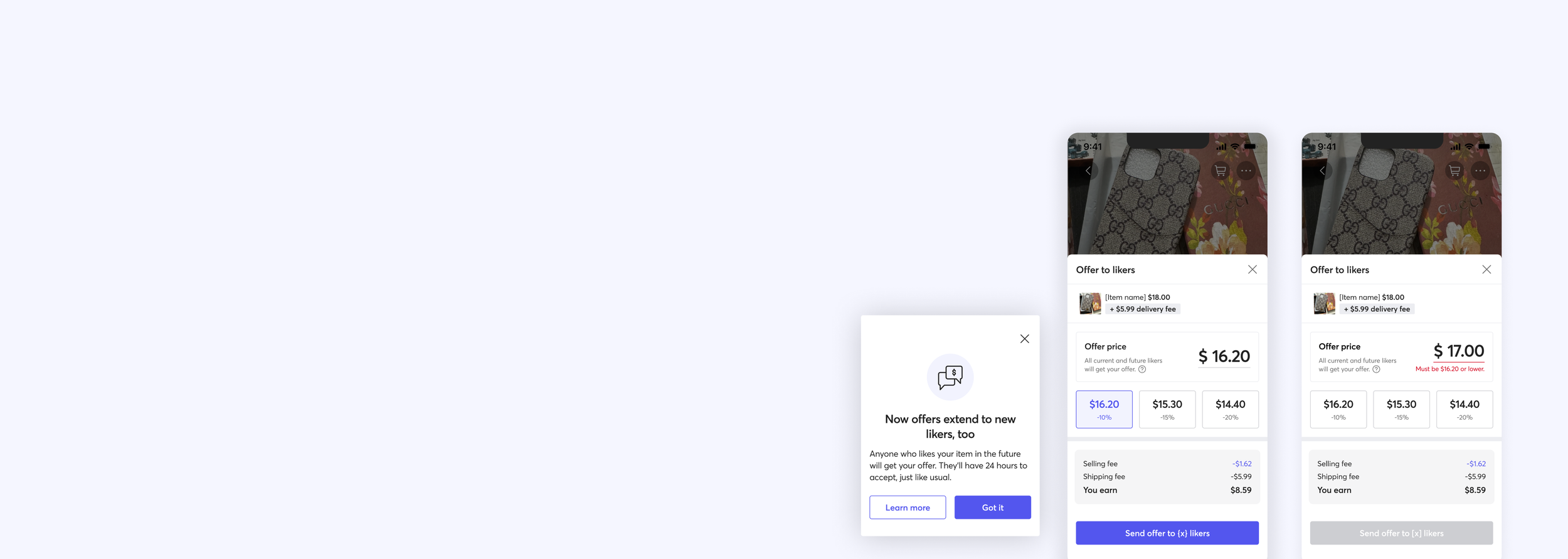
Redesigning Mercari’s Seller Offer System
Empowering sellers with a smarter, automated offer model, lifted qualified offer reach by 20%.
Context
Mercari’s seller promotional feature, Offer-to-Likers, drove 7% of orders, but it's rigid rules prevented sellers from promoting to new Likers unless they dropped prices again. This limited reach and conversion during peak buyer interest. The goal is to redesign the offer logic and interface to let sellers automatically extend active offers to new Likers, without introducing friction.
-
Role
Product designer
Project team lead -
Team
Content designer, PM, UXR, Eng
-
Duration
Feb - March 2023
The problem
Sellers were losing momentum at critical moments
Mercari’s original “Offer-to-Likers” feature allowed sellers to promote their listings by sending a discounted offer to people who liked an item. However, the system had two rigid constraints:
Offers could only be sent once every 24 hours
Each offer required a minimum 10% price drop
These limitations created a frustrating scenario: sellers couldn’t reach newly interested buyers who liked an item after the original offer had been sent.
“I want to make sure new likers get the offer too. I’ve already dropped the price, why should I do it again?”
New offer logic
To support sellers in reaching new likers efficiently, I worked with PM, content designer to brainstorm different ways to reimagine offer logic. From our workshop, we co-created this new offer logic using a Parent Offer model:
An offer could now automatically extend to new likers within a 24-hour window
Sellers no longer needed to lower prices again to reach new interest
Only when choosing to re-engage all likers would a price drop be required
This logic aligned seller needs with platform goals - more reach, less friction.
Challenge #1
Finding the right decision point
My initial approach was to insert a clear “fork in the road” inside the offer modal: Extend the current offer to new likers or create a new offer for all likers.
At a system-logic level, this made sense. However, placing this “fork in the road” inside the offer modal created unnecessary friction. By this point, sellers had already chosen to promote their item - introducing another strategic decision felt out of place.
Reframe the problem
I quickly gather feedback internally and with
New likers appear continuously
Sellers rarely want to segment who does and doesn’t get an offer
The system - not the seller - should handle timing and delivery
This reframed the problem: Sellers don’t want to manually manage branching logic. They want the platform to take care of it, as long as the behaviour is predictable and transparent.
Challenge #2
How much automation do sellers actually want?
Once I realized the “fork in the road” shouldn’t be a manual decision, the next question became:
How much control should sellers have over an automated system?
I explored three design variants that gave sellers varying levels of control over auto-sending offers to new likers:
V1: Toggle
V2: Opt-out unchecked
V3: Opt-in checked
V4: No opt-out control
To validate these directions, I partnered with UXR to run a quick usability sessions with 3 casual sellers and 3 power sellers.
Here’s what we found:
✅ All 6 participants understood the concept of auto-send offers and saw it as helpful
✅ Power sellers strongly preferred default automation, wanting speed and efficiency
✅ Casual sellers wanted to feel more in control, but none opted out when presented with V3
❌ Toggle and checkbox make offer progress slower for power sellers
❌ With the checkbox, casual sellers felt unsure if they’d miss opportunities
After synthesizing usability feedback, I aligned with PM and Eng to evaluate whether offering seller-facing controls was still necessary. Together, we weighed the trade-offs across transparency, technical complexity, and long0term system behavior. We aligned that maintaining automation would create a more predictable experience and reduce repeated manual steps for sellers.
This led us to move forward with V4 (no opt-out control) and focus instead on educating sellers up front about how the logic works through contextual onboarding and in-product messaging.
Challenge #3
Designing for education and trust
Because sellers would no longer configure auto-send themselves, transparency became important in the sellers journey.
Instead of adding persistent UI controls or complex settings, I designed a lightweight, contextual onboarding flow:
Solution: Contextual onboarding flow
One-time modal for returning sellers, clearly explaining how offers now reach new likers
Inline cues on offer UI to reinforce logic subtly over time
“Learn more” link for deeper understanding without blocking actions
Impact after launch…
Through this redesign, the offer system became more flexible, scalable, and better aligned with real seller behavior.
What improved:
+20% increase in outreach coverage to high-intent likers
+15% increase in qualified offer sends
New offer logic increased GMV through-mid-funnel optimization
Established a reusable offer lifecycle framework for future promotional tools